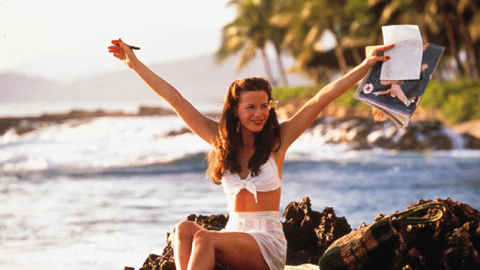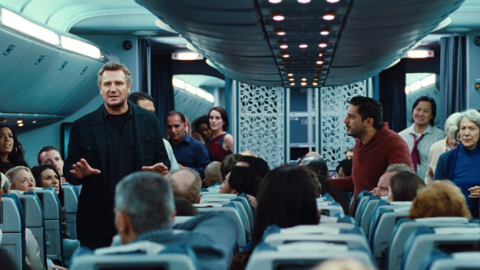Interview: Christopher McQuarrie
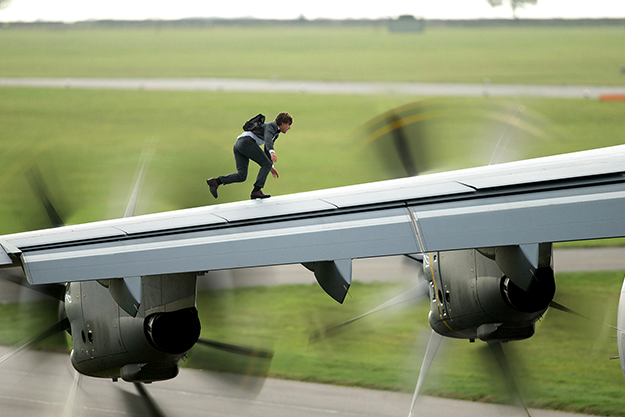
Mission: Impossible – Rogue Nation
The fifth film in a franchise might not sound like the place to go for directorial personality, but Christopher McQuarrie’s Mission: Impossible – Rogue Nation is a surprising exception. After making an early splash as the screenwriter of the indie sensation The Usual Suspects (95), McQuarrie turned to directing with another low-budget genre piece, The Way of the Gun (00)—and then his name disappeared from movie screens altogether until he resurfaced as the writer of Valkyrie in 2008. McQuarrie had been considering getting out of the business after a series of cherished projects (including an Alexander the Great biopic for Martin Scorsese and Leonardo DiCaprio) fell through. But when Valkyrie fell into actor-producer Tom Cruise’s hands, one conversation led to another, and before long, McQuarrie was not only writing but co-producing the picture after bonding with Cruise out of their common love of Sidney Lumet.
The project marked McQuarrie’s immersion into the world of big-budget, star-driven studio films and led to an ongoing partnership with Cruise, a relationship that would yield McQuarrie’s second film as director (2012’s Jack Reacher) as well as a pair of high-profile rewrite assignments (Mission: Impossible – Ghost Protocol, 11, and Edge of Tomorrow, 14). Jack Reacher was a particularly pleasant surprise, old-fashioned in the best sense. A student of Forties film noir, McQuarrie employed all of that tradition’s strengths (chiaroscuro lighting, postwar American weariness, starkly expressive imagery, and straightforward action direction, combined with moral ambiguity, and detail and variety in the ensemble casting) to create one of the smartest and most satisfying Hollywood entertainments of recent years.
Cruise and McQuarrie have reunited for Mission: Impossible – Rogue Nation, which finds Cruise’s character Ethan Hunt on the run from a destabilizing outfit of renegade spies as well as his own government, all the while tracking a mysterious British agent named Ilsa Faust (Rebecca Ferguson), who may or may not be an ally. The dissolution of Hunt’s espionage agency, the IMF, forces him into circumstances in which he can trust virtually no one—a familiar scenario from the writer of The Usual Suspects. Indeed, while Rogue Nation serves the needs of its franchise via a series of spectacular action setpieces, those setpieces intersect perfectly with McQuarrie’s usual thematic obsessions: betrayal, deception, integrity, sacrifice—ideas present in everything from McQuarrie’s feature-writing debut Public Access (in which a stranger exposes the hidden secrets of a placid American town) to Valkyrie’s chronicle of a secret Nazi plot to assassinate Hitler.
In Rogue Nation, the visual expression of those ideas remains consistent with the formal style established in McQuarrie’s previous work: a robust use of the anamorphic frame, vivid colors and film grain (both Jack Reacher and Rogue Nation were shot on 35mm), gliding camera movement, and a sparing use of close-ups and coverage. If anything, the greater resources at McQuarrie’s disposal have enabled him to be the director he always wanted to be: an old-school craftsman following in the footsteps of John Sturges and Don Siegel, merging his personal preoccupations with mass-market entertainments. In an era when so many independent filmmakers lose their voices in the transition to big-budget studio productions, Christopher McQuarrie seems to have found his.
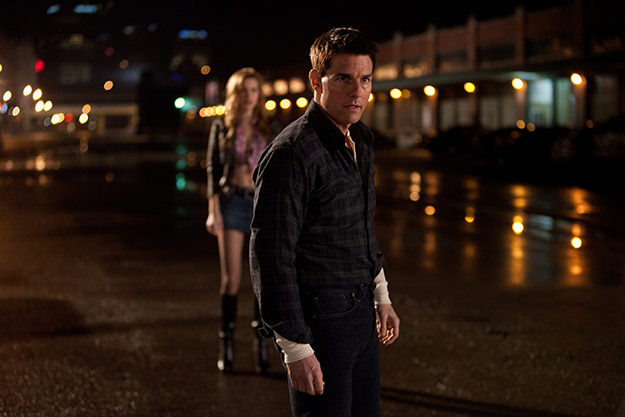
Jack Reacher
I want to start by talking about your visual style, because one of the things I really like about both Rogue Nation and Jack Reacher is the classicism that both movies exhibit. They remind me almost of Minnelli movies from the Fifties and Sixties in the way you use the ’scope frame and let the scenes play out in wide masters for as long as possible. It’s not a style that’s entirely in fashion in contemporary blockbusters, most of which I find kind of suffocating.
Well, the first thing I try to communicate to my crew is that there will be no shaky-cam and no rack zooms, because those techniques are only used to hide the fact that there is no energy. When you eliminate those gimmicks you’re confronted with the reality of the shot you have in front of you, and nine times out of 10 you say to yourself: “This just isn’t working.” Then you have to find ways of infusing the shot with energy and excitement, and ask yourself what you can do to sustain the shot so that you’re not relying on staccato editing—because I know what you’re talking about when you say you feel suffocated. It has to do with two things: you don’t know where you are, and you’re not being given the time to make that determination.
I have a very rational, straightforward approach. Rule number one is clarity, and rule number two is geography—I start with that, and then sometimes I have to push myself to get outside that box of clear, simple storytelling. Some of what you’re saying has to do with my fixation with anamorphic cinematography, and some of it has to do with my belief that the kind of shaky-cam, rapid-editing style that often gets used is based in fear. It’s based in this fear that the audience will get bored. I don’t believe that; I don’t believe that there’s an erosion caused by YouTube and video games and all that other stuff. The erosion comes when people aren’t exposed to classical storytelling. Your observation about the style is correct in that we never cut [in Rogue Nation] unless there’s a reason to cut—each shot is chosen very specifically to move the emotional progression forward. All I’m interested in is making you a bystander to the action when necessary, and then at key moments making you the protagonist—I’m moving you back and forth between those points of view.
I love that you referenced Vincente Minnelli. I don’t often talk about him, but he’s a major influence, especially Some Came Running. I really envy the way guys like Minnelli and Lumet and John Sturges just let the camera sit in the corner of the room—they build carefully designed sets and let things play out almost like a play, and they very carefully choose when to jump in for a close-up because a specific line means something in terms of raising the dramatic tension. It’s very hard in modern filmmaking because you don’t have the time to rehearse, you don’t have the time to develop the screenplay the way those filmmakers would. Often you’re building the movie in the editing room as opposed to starting with a careful plan.
It must be hard keeping that kind of careful plan in mind and sticking to it when you’re on a huge movie like Mission: Impossible – Rogue Nation.
When Tom first suggested it to me, I was terrified. I had worked on Ghost Protocol behind the scenes and saw how difficult and massive it was, and I’d worked on other big movies as an on-set script doctor and producer and seen how challenging they can be. I also know how daunting the script development process on these kinds of movies can be, so my natural inclination was to run.

Mission: Impossible – Rogue Nation
I don’t even know where you would start on a script like this. Do you begin with a thematic idea you want to explore, or with the idea of the syndicate, or the notion of bringing in a new female character—
The woman was job one. I laid the previous four movies on top of one another and realized that the one thing I hadn’t seen was a woman who was an equal to Tom and not just a member of his team. I wanted someone who would keep him on his toes and drive the story forward, and provide a kind of romantic element but not an actual romance. Something I’ve learned over the course of my collaborations with Tom is that when we reach for an emotion—when we try to impose an emotion on the characters or the scene that is not naturally presenting itself—it never works. It feels synthetic. The movie tells you where it wants to go, and you have to let it be romantic when it wants to be romantic and funny when it wants to be funny without forcing it.
So the second question for me was figuring out the structure of the movie, and we decided to just start with the action—we thought about what kinds of action setpieces we always wanted to do, and then we put them into some semblance of an order to try to figure out what journey that would put our characters on. Drew Pearce came in and wrote the first draft based on that construct, then he had to leave to work on another movie and I rearranged two sequences and changed one specific detail. I took the underwater sequence and the motorcycle chase and put them back to back, creating one monster action sequence in the middle of the movie. When I did that, it created a great relentless setpiece, but I blew up the movie—suddenly, characters’ motives that made sense in the previous draft didn’t work anymore. If Ilsa is running from both Ethan and Lane, where is she running to? Figuring that out necessitated the creation of act one and the introduction of British intelligence into the movie, and that in turn led us to all of the consequences in the third act. So action really drove story.
One of the things I find interesting about your career is that you made your name as a screenwriter of original pictures, and then when you started directing, you did an original screenplay, an adaptation of a novel, and then a sequel where you have preexisting characters and motifs to work with but essentially have to create an original story. What are the pleasures and the challenges of each type of writing? Are they considerably different?
Yeah, they are actually. There are a number of challenges writing an original story, primarily just coming up with something new and surprising that satisfies you and isn’t repeating your past work or anyone else’s. Then of course there’s the fact that we don’t live in an age of readily accepted original material in terms of financing. There’s a risk in taking valuable time out of your day to write something that probably won’t get made unless it has great franchise potential. That’s opposed to my bread and butter, which is coming on other people’s productions to help them realize their movies. The challenge of my career has been making that adjustment and finding a way to take pleasure in helping other people make their movies as opposed to trying to make my own.
That gets us into the adaptation portion of your question. I love history and true stories, which take you more into the realm of adaptation because you’re drawing from something that already exists, whether it’s a newspaper article or an anecdote or a book, and turning that into a screenplay. Now, franchise movies belong to a whole discipline in and of itself. The comic book movies I’ve worked on [X-Men, Wolverine] and some of the science-fiction movies that I’ve worked on. If you adhere too much to logic and become adamant about having it track the way you would a piece of original material, the more they start to bog down. They don’t want an explicit story—and when I say “they,” I don’t mean the audience, I mean the film itself. What they want is an experience, and you have to learn when information is important and when information is redundant. Now, for safety’s sake Tom and I over-explain everything—you wouldn’t believe how many different ways the characters explained the rules in the early versions of the movie. That way we can make sure that we’re being as clear as we possibly can in the easiest way for the audience to digest it. That’s just a necessity for a movie that has to be mass-marketed to a global audience, most of whom are either reading the dialogue via subtitles or seeing it dubbed.
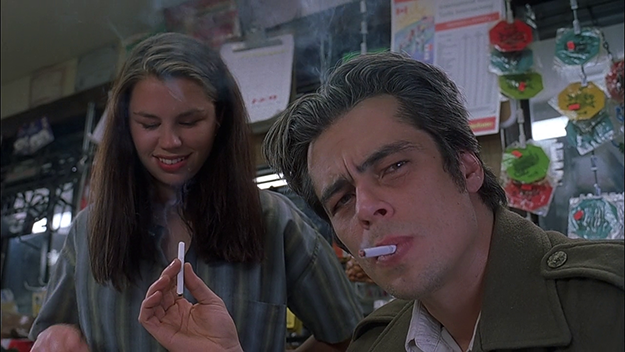
The Way of the Gun
That gets at something else I find interesting about your career, which is the quantum leap you took in terms of budget and scale from your first film, The Way of the Gun, to your second, Jack Reacher. What was that learning curve like going from the indie world to a big studio Christmas release with a major star?
It really has its roots in Valkyrie. There were 12 years between directing The Way of the Gun and directing Jack Reacher, and there were seven years between The Way of the Gun and Valkyrie. Valkyrie was my first experience as a producer, which wasn’t something I intended on or sought out. I was asked to do the job and I did it, and over the course of the film I acquired more and more responsibility. That, even more than Jack Reacher, prepared me to take on something like Mission: Impossible. Also, I worked on Ghost Protocol and came in 10 weeks into a 17-week shoot; they had shot a lot of exteriors and a lot of the stunts, but they hadn’t shot a lot of the story. I spent the first six days simply meeting with department heads and sitting with the editor watching all the dailies, finding out which sets have been struck, which are still standing, which need to be built; asking myself what to do if there’s a scene I want to delete but they’ve already started building the set—how do I repurpose that set to get it to work with the story I’m telling? All of that gave me a lot of insight into the nuts and bolts of the inner workings of a $100 million-plus movie. Adding to that, three hours after I finished Jack Reacher, I was working on Edge of Tomorrow; I was there for pickups and reshoots and learned a lot about budgeting and scheduling and things of that nature. We were shooting material to thread that very complicated movie together, and in the midst of that Tom raised the idea of me directing the next Mission: Impossible.
How do you keep the whole production under your control when you’re making something with so much scale and so many moving parts?
If you pick the right people, you’re not going to lose control of the movie. The only way you really lose control of the movie is if you can’t make a decision. If you can’t make a decision then the decision will be made for you, or the movie will simply break down. You know, there are filmmakers—very successful filmmakers—who are very good at choosing people who will support them and protect them from themselves. I’m not one of those filmmakers. I go in with very specific ideas—not always the right ones—and I push for those as hard as I can. It helps that I was writing and directing and that a lot of the writing I was doing was while I was in production. I was constantly rewriting the script and trying to find the end of the movie. The benefit of that was that no one could really do anything until I generated the pages that told them what to do.
It seems so crazy to me to write something like this as you go given how complicated it is. What was your main focus to keep everything held together?
Again, it’s that character of Ilsa and the question of where her allegiances are and what she’s up to. We played a lot with it in the earlier drafts, but what we ended up with is the idea that she lies only once in the movie. You have to go back and watch the movie a second time to find where that lie is—the rest of the time she’s telling the truth, but the circumstances around her make it seem as though everything she’s saying is a lie. That approach made it really fun and easy to write her character, because you didn’t have to keep track of anything. She’s the living embodiment of that idea every criminal knows: “Try to tell the truth, it’s the easiest thing to remember.” Then as far as the various double-crosses and mysteries go… well, a lot of those things were mysteries to us! When Ving Rhames’s character is looking at a screen [in a scene where he and his partners uncover a key piece of information] and saying, “Oh man, do I got it,” Ving asked me, “What do I got?” and I said, “I don’t know yet, I haven’t figured it out. But however you say it, I’ll write to that and that’s what I have to earn.” The movie was governed by emotional payoffs, which then needed story to support them.
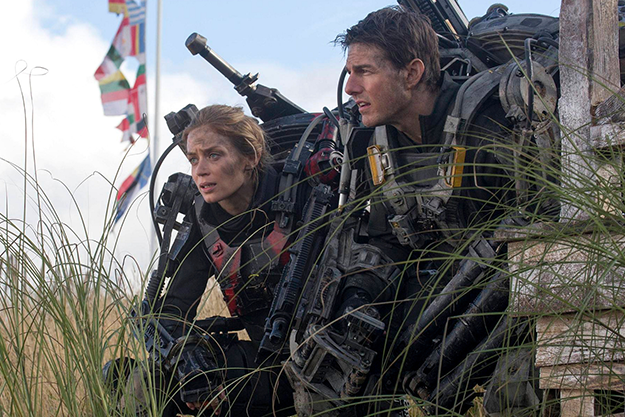
Edge of Tomorrow
One of the movie’s real strengths is Joe Kraemer’s score, which does an interesting job of integrating the original Lalo Schifrin Mission: Impossible theme into an overall orchestral tapestry that also has references to opera. How do you approach music in your work?
First of all, I don’t use temp music when I’m editing, because I think it does two bad things. One is that it gives you the false impression that a scene is working when it’s not, and the other is that you fall in love with the temp score and then no piece of original music is ever going to satisfy you. Then you find yourself tempted to tell the composer, “just copy the temp”—that happens a lot. If you know your movie music, you can watch films where they’ve done that and tell what they were copying. For this film, Joe wanted to go back to the TV show and only use instruments that were available in 1966 when Schifrin wrote his theme music. So there are no synthesizers—the score is purely orchestral. But Joe didn’t want the score to feel archaic, so he developed synthesized sounds with the trumpets playing the same notes over and over again at an incredible staccato rate. That gives you a sensation of something only a synthesizer can do, but it’s all being done with a 90-piece orchestra. It gives a kind of fluttering heartbeat to the movie right from the start, and when he demonstrated it for me I said: “That’s great, it works for me thematically, and I want you to run with it throughout.”
The way Joe and I generally work is that we’ll sit down and he’ll play me a bunch of music that he’s experimenting with, sometimes not even for a specific scene—or sometimes he’ll write a piece of music for one scene and I’ll decide that it works better somewhere else. From that experimentation the score grows organically . . . In the train station scene, Joe wrote music to start earlier than it ends up in the finished movie. In that case I moved the whole cue 10 seconds later without changing anything else, and it shifted the emotional emphasis from Ilsa’s line to Ethan’s reaction, musically leading the audience to share Ethan’s point of view.
On this film we had such a compressed post-production schedule that Joe couldn’t confirm the score measure for measure before he had to start orchestrating. I only heard about 40 percent of the score before Joe starting recording it. Ironically, the points when I drove Joe crazy came from the fact that we did use temp music when we screened the film for test audiences, and it was very effective. I didn’t want Joe to match it, but I did want him to top it, so I was constantly pushing on him, and the movie’s better for it. Also, when we started putting music with the movie we realized that our original intention—which was to keep it spare—wasn’t going to work. The movie was calling out for more music.
And yet there are some very effective action sequences that have very little music, or no music at all. Is that a decision that is made conceptually from the beginning, or do you drop certain cues out during the mix?
It’s very methodical. In the opening action sequence, the sound design would get too monotonous if you didn’t have music—plus it’s the beginning of the movie, you need to set the tone. But the car chase—which, like the car chase in Jack Reacher, doesn’t have music—has constantly shifting rhythms in its sound design, from motorcycles to cars, from inside the car to outside the car, in the motorcycle driver’s POV, outside the group of motorcycles. Those sounds are the music of the sequence. But to address your question, we did score it to protect ourselves—we never had any intention of using the music, but in early test screenings people had pace issues and we started to worry that the chase was a little long. We determined that you could sustain the chase without a score until Tom flips the car end over end, at which point the sequence shifts to motorcycles and no car. At that point we needed to tell the audience that we’ve entered another level—also, with less vehicular variety the motorcycles themselves would start to sound monotonous. So we put music with the motorcycles and left the car chase alone, and suddenly the notes about pacing went away.
The biggest challenge in terms of the scoring was the third act of the movie. We were getting notes from the audience saying that they felt like the movie ended three or four times, and the studio thought we needed to figure out what we could cut to streamline it. Tom was the one who astutely observed that the problem could be solved with the music. He said, “Create music that gives the sense that it’s all one sequence,” so Joe was given that mandate and subtly kept the audience from feeling like the scene was changing, even though there was a constant change of scenery.
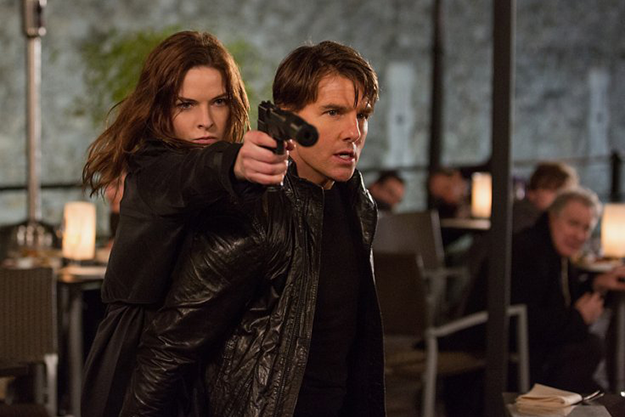
Mission: Impossible – Rogue Nation
Even more than most movies, this seems like one where you were really discovering it as you went. Were there any surprises in the editing room, like finding out that you needed pieces you didn’t have, or realizing you had written yourself into corners?
Just the opposite, actually—we found that we shot things that we didn’t need. The only problem in the editing room was that there were two sequences I was convinced didn’t work. I knew we had the plot and story, but I entered this black hole and thought the action was in total disarray. My editor, Eddie Hamilton, calmed me down and said, “It’s gonna be great,” and he got me back on track. With a film like this, you just have to keep your head down and take it a step at a time, trusting that it will all come out right in the end.



